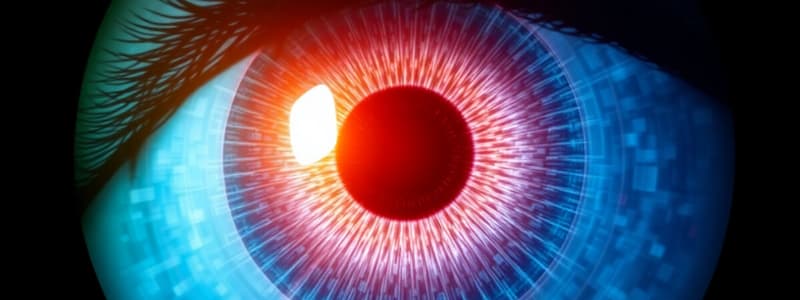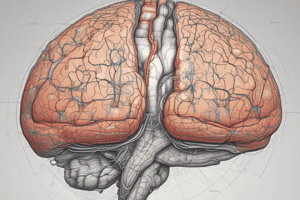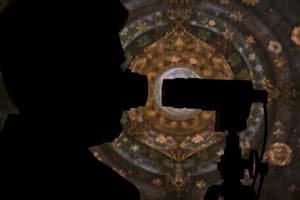Podcast
Questions and Answers
Which visual field pattern is MOST suitable for assessing end-stage glaucoma and maculopathies, such as those caused by hydroxychloroquine?
Which visual field pattern is MOST suitable for assessing end-stage glaucoma and maculopathies, such as those caused by hydroxychloroquine?
- 10-2 pattern (correct)
- Esterman Binocular Field
- 30-2 pattern
- 24-2 pattern
A patient presents with a visual field defect characterized by nasal steps and significant horizontal meridian sensitivity differences. This pattern suggests a condition that:
A patient presents with a visual field defect characterized by nasal steps and significant horizontal meridian sensitivity differences. This pattern suggests a condition that:
- Indicates a homogenous reduction of sensitivity across the entire visual field.
- Is commonly associated with media opacities like cataracts.
- Respects the horizontal meridian. (correct)
- Is best evaluated using Esterman Binocular Field testing.
When performing standard automated perimetry, which central visual field area is MOST commonly evaluated?
When performing standard automated perimetry, which central visual field area is MOST commonly evaluated?
- The entire visual field, from 0° to 90°
- The central 5°
- The central 24° or 30° (correct)
- The peripheral 60°
A patient's visual field test reveals a homogenous reduction of sensitivity across the entire field. Which of the following is the MOST likely cause?
A patient's visual field test reveals a homogenous reduction of sensitivity across the entire field. Which of the following is the MOST likely cause?
Compared to the 30-2 visual field pattern, the 24-2 pattern offers what distinct advantage?
Compared to the 30-2 visual field pattern, the 24-2 pattern offers what distinct advantage?
Which of the following BEST describes the threshold value determined during a Full Threshold (FT) visual field test?
Which of the following BEST describes the threshold value determined during a Full Threshold (FT) visual field test?
A clinician wants to minimize the duration of a visual field test without significantly sacrificing accuracy. Which strategy is MOST appropriate?
A clinician wants to minimize the duration of a visual field test without significantly sacrificing accuracy. Which strategy is MOST appropriate?
Which of the following is a key characteristic of the SITA Fast (SF) strategy that allows for faster testing times compared to SITA Standard?
Which of the following is a key characteristic of the SITA Fast (SF) strategy that allows for faster testing times compared to SITA Standard?
What is the primary disadvantage of using the SITA Faster strategy for visual field testing?
What is the primary disadvantage of using the SITA Faster strategy for visual field testing?
When is the Esterman Binocular Field test MOST appropriate?
When is the Esterman Binocular Field test MOST appropriate?
A patient needs to have specific visual field (VF) measurements to be eligible to drive and obtain their license. Which of the following VF ranges are required?
A patient needs to have specific visual field (VF) measurements to be eligible to drive and obtain their license. Which of the following VF ranges are required?
Standard automated perimetry uses a white stimulus on a white background. Approximately what percentage of retinal ganglion cells (RGC) must be lost before a visual field defect (VFD) is detected using this method?
Standard automated perimetry uses a white stimulus on a white background. Approximately what percentage of retinal ganglion cells (RGC) must be lost before a visual field defect (VFD) is detected using this method?
Which of the following statements best describes the advantage of short-wavelength automated perimetry (SWAP) over standard automated perimetry?
Which of the following statements best describes the advantage of short-wavelength automated perimetry (SWAP) over standard automated perimetry?
In a Humphrey Field Analyzer (HFA), the intensity of the stimulus ranges from 10,000 to 0.1 apostilbs (asb). Why are these apostilb values converted to logarithms and then to decibels (dB) for clinical use?
In a Humphrey Field Analyzer (HFA), the intensity of the stimulus ranges from 10,000 to 0.1 apostilbs (asb). Why are these apostilb values converted to logarithms and then to decibels (dB) for clinical use?
In the Humphrey Field Analyzer (HFA), an intensity of 10,000 apostilbs is given a value of 0 dB. What does this signify?
In the Humphrey Field Analyzer (HFA), an intensity of 10,000 apostilbs is given a value of 0 dB. What does this signify?
What target size is typically used in the Humphrey Field Analyzer (HFA) for standard perimetry?
What target size is typically used in the Humphrey Field Analyzer (HFA) for standard perimetry?
What does it indicate when fixation losses are greater than 20%?
What does it indicate when fixation losses are greater than 20%?
A patient has a high false positive rate during perimetry. Which of the following is LEAST likely to be observed in their visual field test results?
A patient has a high false positive rate during perimetry. Which of the following is LEAST likely to be observed in their visual field test results?
During visual field testing, a stimulus is presented at a location where the patient has previously seen it, but the patient does not respond this time. What does this likely indicate?
During visual field testing, a stimulus is presented at a location where the patient has previously seen it, but the patient does not respond this time. What does this likely indicate?
In an abnormal visual field, what does a high false negative rate suggest about the patient's responses during the test?
In an abnormal visual field, what does a high false negative rate suggest about the patient's responses during the test?
A patient reports difficulty seeing objects in dim light, but can see them when they are brighter. Which type of visual field defect is the MOST likely explanation?
A patient reports difficulty seeing objects in dim light, but can see them when they are brighter. Which type of visual field defect is the MOST likely explanation?
Which of the following BEST describes how neurological visual field defects typically manifest?
Which of the following BEST describes how neurological visual field defects typically manifest?
A visual field test reveals a defect located in the inferior nasal quadrant. Assuming a retinal cause, where is the corresponding retinal pathology MOST likely located?
A visual field test reveals a defect located in the inferior nasal quadrant. Assuming a retinal cause, where is the corresponding retinal pathology MOST likely located?
Which condition is MOST commonly associated with generalized depression of the visual field?
Which condition is MOST commonly associated with generalized depression of the visual field?
In glaucoma management, why is it important for Optical Coherence Tomography (OCT) results to correlate with visual field (VF) test results?
In glaucoma management, why is it important for Optical Coherence Tomography (OCT) results to correlate with visual field (VF) test results?
A patient with retinitis pigmentosa (RP) may undergo visual field testing for what primary purpose?
A patient with retinitis pigmentosa (RP) may undergo visual field testing for what primary purpose?
What distinguishes glaucomatous visual field defects from neurological visual field defects?
What distinguishes glaucomatous visual field defects from neurological visual field defects?
Which characteristic is MOST typical of visual field defects resulting from retinal causes?
Which characteristic is MOST typical of visual field defects resulting from retinal causes?
What is the MOST important characteristic of an absolute scotoma?
What is the MOST important characteristic of an absolute scotoma?
Why is threshold field testing considered superior to confrontation visual field (CVF) screening for diagnosing visual field defects?
Why is threshold field testing considered superior to confrontation visual field (CVF) screening for diagnosing visual field defects?
Flashcards
Horizontal Meridian
Horizontal Meridian
Glaucoma visual field defects often respect this anatomical line.
24-2 or 30-2 Visual Fields
24-2 or 30-2 Visual Fields
These are commonly used to assess the central field of vision.
Media Opacity
Media Opacity
What a homogenous reduction in sensitivity is most likely caused by.
30-2 Pattern
30-2 Pattern
Signup and view all the flashcards
24-2 Pattern
24-2 Pattern
Signup and view all the flashcards
10-2 Pattern
10-2 Pattern
Signup and view all the flashcards
Full Threshold Strategy (FT)
Full Threshold Strategy (FT)
Signup and view all the flashcards
SITA Standard
SITA Standard
Signup and view all the flashcards
SITA Fast (SF)
SITA Fast (SF)
Signup and view all the flashcards
Esterman Binocular Field
Esterman Binocular Field
Signup and view all the flashcards
Visual Field Depression
Visual Field Depression
Signup and view all the flashcards
Scotoma
Scotoma
Signup and view all the flashcards
Absolute Scotoma
Absolute Scotoma
Signup and view all the flashcards
Relative Scotoma
Relative Scotoma
Signup and view all the flashcards
Neurological VFD
Neurological VFD
Signup and view all the flashcards
Retinal VFD
Retinal VFD
Signup and view all the flashcards
Retinal VFD Location
Retinal VFD Location
Signup and view all the flashcards
Glaucomatous VFD
Glaucomatous VFD
Signup and view all the flashcards
Bjerrum Area
Bjerrum Area
Signup and view all the flashcards
Early Glaucoma VFD
Early Glaucoma VFD
Signup and view all the flashcards
Driving Visual Field Requirements
Driving Visual Field Requirements
Signup and view all the flashcards
Standard Automated Perimetry (SAP)
Standard Automated Perimetry (SAP)
Signup and view all the flashcards
Short-Wavelength Automated Perimetry (SWAP)
Short-Wavelength Automated Perimetry (SWAP)
Signup and view all the flashcards
Humphrey Field Analyzer (HFA) Intensity
Humphrey Field Analyzer (HFA) Intensity
Signup and view all the flashcards
Apostilbs to Decibels Conversion
Apostilbs to Decibels Conversion
Signup and view all the flashcards
10,000 Apostilbs Value
10,000 Apostilbs Value
Signup and view all the flashcards
Fixation Losses (FL)
Fixation Losses (FL)
Signup and view all the flashcards
Fixation Loss Calculation
Fixation Loss Calculation
Signup and view all the flashcards
False Positive Rate (FP)
False Positive Rate (FP)
Signup and view all the flashcards
False Negative Rate (FN)
False Negative Rate (FN)
Signup and view all the flashcards
Study Notes
- Visual fields are useful for diagnosing multiple conditions and monitoring their progression.
Examples of Visual Field Use
-
Glaucoma management requires OCT and VF correlation for diagnosis.
-
Diagnosis and management of neurological diseases is another example.
-
Diagnosis and management of retinal diseases, such as ARMD, where patients may use an Amsler grid at home
-
Certification of visual function for patients with visual disabilities like low vision or RP
-
Screening visual fields can reveal defects, but threshold field tests are more diagnostically capable.
-
Automated visual fields aren't suitable for every patient.
Depression
- Defined as areas of reduced sensitivity without surrounding normal sensitivity.
- Cataracts and uncorrected refractive errors can cause this.
- It means that the eye can see something, but less than it should
- VF general depression is most common in cataracts.
- Can also result from uncorrected refractive error or miosis.
Scotoma
- This is a visual field defect surrounded by normal vision
- Localized defects are described by size, depth, and location for diagnostic purposes.
- Absolute scotomas are areas where nothing is seen (black).
- Relative scotomas are areas where vision is dimmer.
VF Defects
- Absolute scotomas: Stimuli at maximum brightness aren't visible.
- Relative scotomas: Low luminance stimuli can't be seen, but larger or brighter stimuli can be seen.
Types of VF Defects
- Glaucomatous VF loss follows a specific pattern.
- Neurological VF loss
- Retinal VF loss
Neurological VFD
- Respects the vertical meridian, stopping abruptly at the midline.
- Most commonly hemianopic
- Majority present in the central 30° of the visual field
- May not be completely noticeable initially
Retinal Visual Field Loss
- Defects are often deep with steep borders and highly reproducible, similar to "similar & DNI"
- The affected area of the retina is opposite the VF defect.
- Example: superior temporal RD results in an inferior nasal VFD.
Glaucomatous VFD
- Defects first occur in the nasal or arcuate region (Bjerrum area).
- May extend from the blind spot to the macular region, ending abruptly at the horizontal meridian nasally.
- Typically occurs first in the Bjerrum areas of the upper and lower hemifields.
- Early glaucomatous defects present as relative scotomas or small regions of decreased sensitivity.
- Tends to respect the horizontal meridian, showing nasal steps.
- Significant horizontal meridian sensitivity differences can be an indicator
- Visual fields are commonly performed to evaluate the central 24° or 30°.
- A homogenous reduction of sensitivity alone is almost never from glaucoma.
- Media opacity like cataracts or miosis can cause this
Types of Perimeters
- 30-2 Pattern: Tests 76 points in the central 30° field with a symmetrical 6° grid pattern
- 24-2 Pattern: Tests 54 points in the central 24° field, extends nasally to 30°, with more testing points nasally
- 10-2 Pattern: Tests the central 10° with 2° spaced test points; standard for end-stage glaucoma & maculopathies
Full Threshold Strategy (FT)
- A suprathreshold stimulus is presented based on previous threshold values.
- Intensity decreases until the stimulus disappears, then increases until it's seen again.
- The threshold value is the last stimulus seen.
- Longer test time
Swedish Interactive Threshold Algorithm (SITA)
- SITA Standard: Offers high accuracy and short test time (50% less than standard HVF test); takes 7-11 minutes per eye.
- Very small differences are acceptable; re-measurement may occur, lengthening the test.
- SITA Fast (SF): Is a fast threshold test with similar sensitivity to FT
- Allows for more variability between repeated measurements for faster testing.
- Reduces threshold test time to 3-5 minutes without sacrificing accuracy (70% less time).
- SITA Faster: Takes about 2 minutes per eye; increases patient reliability by not using false negatives.
Esterman Binocular Field
- Assesses the full VF view, not monocular vision.
- Relevant for patients who have had a stroke, etc.
- Determines if sufficient VF to drive and obtain a license.
- Horizontal range: +/- 75 degrees.
- Superior range: 35 degrees.
- Inferior range: 55 degrees.
Stimulus
- Standard automated perimetry uses a white stimulus on a white background for detecting VFD, when about 40% of the RGC have been lost
- Short-wavelength automated perimetry (SWAP) measures blue wavelength with a blue stimulus on a yellow background.
- SWAP is more effective at detecting early glaucoma damage, up to 5 years earlier.
- Intensity in a Humphrey Field Analyzer (HFA) ranges from 10,000 to 0.1 apostilbs (abs).
- Apostilbs relate to a test target's luminance projected onto the white bowl's interior.
- Apostilb values are converted to logarithms, then decibels, for easier use with smaller numbers.
- 10,000 apostilbs is given a value of (0), indicating zero retinal sensitivity.
- This target has the highest intensity and if it cannot be seen, it is considered an absolute scotoma (blind).
Target Size
- Target size is identified using roman numerals.
- HFA typically uses Goldmann III (4 mm²) but varies the target brightness.
- The stimulus size can be changed to be larger or smaller as needed
- Goldmann V is used for severely disturbed fields such as RP
- Goldmann o used for clinical research, not clinical practice
Interpretation: Fixation Losses (FL)
- Occur when a patient reports seeing a stimulus in the physiological blind spot area.
- Calculated as the number of times stimulus reported in the blind spot divided by total presentations.
- If the patient responds, it's assumed they lost fixation and/or the blind spot isn't in the original location.
- Could also be examiner error: not patching the contralateral eye or placing the patch incorrectly.
- Fixation losses over 20% indicate poor patient reliability.
- Verify if FL are happening:
- Patient's gaze: drifted from fixation, so stimulus falls on a seeing part of the retina
- Location of the blind spot: if it is mapped out incorrectly, Patient readjusted head position after the BS had been plotted
False Positive Rate (False POS errors)
- “Trigger Happy” patient
- A high (>15-20%) false positive rate indicates an unreliable field
- High FP rate is the MOST devastating when it comes to interpretation
- High FP rates will be accompanied by:
- Suprathreshold levels
- Mean deviation (MD) with a high (+) value
- High fixation losses
- Patchy loss on the grayscale
- White scotoma: white areas in the grayscale indicating impossibly high threshold levels
- Pattern deviation is worse than the total deviation
False Negatives (False Neg Error)
-
Results when a stimulus is presented at a point that's already been seen, yet the patient doesn't report it.
- May indicate patient fatigue, sleepiness, changed response criteria, or actual field loss where sensitivities are variable.
-
Greater than 15-20% means poor patient reliability
-
In a normal field, a high FN rate results from patient inconsistency in responses.
-
In an abnormal field, a high FN rate occurs because there is highly variable visibility during the test in abnormal regions
-
Tracking System (Gaze Monitor) to help determine the instance a patient closes their eyelids and makes deviation
-
Deviation upward indicates gaze was not on the fixation target.
- The magnitude of the deflection indicates the extent of the errant fixation
-
Large deviation downwards indicates a blink (longer than expected)
- Small downward deviations indicate that the computer cannot tell the direction of the patient's gaze
-
A pattern which resembles a “city skyline” indicates dubious fixation reliability
-
Short-term fluctuations tell us if the patient is consistent.
- A point is tested twice during a test period
- If abnormal (greater than 3dB): Inattentive patient or Patient with a disease visual system
-
Low Fluctuation: <1.5dB
-
Normal Fluctuation: 1.5-2dB
-
Medium Fluctuation: more than 2 but less than 3dB
-
High Fluctuation: over 3dB
-
Raw data is threshold sensitivity values in decibels
-
Grayscale displays interpolated raw dataIs a direct representation of the absolute threshold levels in raw data field
-
The darker the zone, the less sensitive the area
-
This doesn't provide information about the depth of the scotoma.
-
Total deviation (TD) represents the difference in dB between the patient results and age-corrected normal values.
-
Pattern Deviation (PD) corrects for overall sensitivity of the field by removing generalized depressions to identify localized abnormalities.
-
Pattern deviation flags areas that deviate significantly from normal, correcting first for any overall change in the height of the hill of vision.
-
The instrument assumes than an overall depression in the hill of vision is secondary to opacities in the media or miosis.
-
Pattern Deviation allows to follow over the years after media opacities develop. It will factor out the depression caused by a cataract
-
Is an excellent determinant of the depth of the scotoma
-
Island of Vision
-
Looks at pattern deviation taking away generalized loss
-
Probability (p) values indicate the frequency of the tested value occurring in a normal age-matched population.
-
Deviations are shown if the threshold is worse than the bottom 5% of normal for that age
-
Interpretation of the data leads to next bullet point
More Interpretation
- The finding of an abnormal point is not sufficient to conclude that a field is abnormal
- Abnormality of a field as a whole must be judged on the basis of finding sufficient abnormality in a cluster of points in a pattern that is typical of the associated clinical findings
- A single statistically significant point may not be clinically significant, but a group of connected points that all reach statistical significance is unlikely to be normal
- A cluster of three or more connected points on the same side of the horizontal meridian that all reach statistical significance, with at least one of the points reaching the p<1% significance level, is diagnostic of glaucomatous visual field if the defect is repeatable
Global Indices
- Mean Deviation (MD): Represents the overall depression (-) or elevation (+) of the VF with scotomas or depression compared to an age-matched normal.
- A positive (+) number indicates that the average sensitivity is above the normal for age
- A negative (-) number indicates that the average sensitivity is below the average age-matched normal
- Signifies the overall severity of the field loss, interpreting the severity of the field loss at individual locations and the area of the field involved
Pattern Standard Deviation (PSD)
-
Expressed in dB, PSD indicates the smoothness of the hill of vision.
- If there is VF loss, it determines how evenly the visual loss is spread across the field
-
This is a weighted average of the pattern deviation
- If the averaged amount that each point in the field deviates from the expected value after it has been adjusted for a general depression or suprasensitivity
-
This is a measure of how different points are from one another within the field
-
A high PSD indicates isolated depression in the normal hill of vision or variability in the patients' responses
-
Any value of 2dB or greater will have a (P) indicating the significance of the deviation.
-
Minimally influenced by cataracts
-
If PSD is outside the normal range, the probability that such a value could exist in a normal population is given.
-
Corrected Pattern Standard Deviation (CPSD): This is a calculated measure in dB of how much the total shape of the patient's hill of vision deviates from the shape of the normal hill of vision after adjustment.
-
Glaucoma Hemifield Test (GHT): In glaucoma, the upper and lower hemispheres of the field are significantly different
-
For GHT, points in the five smaller zones get grouped together (above and below the horizontal meridian) for testing
-
Used probability values are used instead of threshold values
-
The mirror images are compared to one another
GHT Interpretations
- 1. GHT outside normal limits (ONL): A score assigned to each member of mirror image zones based on percentile deviation from normal. A message will appear if:
- The difference between the mirror image zones can be seen in
Studying That Suits You
Use AI to generate personalized quizzes and flashcards to suit your learning preferences.




